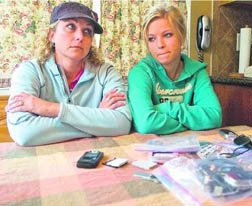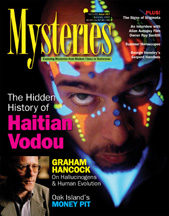-
WE CONTROL EVERYTHING DEPARTMENT -
Families Suffer From Eerie
Stalker

Tacoma, WA - Three Fircrest families receive death threats via cell
phone. Even when the phones are off. Even when they get new phones.
Heather Kuykendall and her daughter, Courtney, 16, display the cell
phones they’ve abandoned in an attempt to cut off a stream of
threatening messages from mysterious harassers. Courtney started
receiving the calls in February. Other families have gotten them, too.
Investigators suspect it’s an elaborate hoax.
Maybe it’s just a long-running prank, but the reign of terror endured
by three Fircrest families buries the needle on the creepy meter.
For four months, the Kuykendalls, the Prices and the McKays say,
they’ve been harassed and threatened by mysterious cell phone stalkers
who track their every move and occasionally lurk by their homes late at
night, screaming and banging on walls.
Police can’t seem to stop them. The late-night visitors vanish before
officers arrive. The families say investigators have a hard time
believing the stalkers can control cell phones without touching them
and suspect an elaborate hoax. Complaints to their phone companies do
no good – the families say they’ve been told what the stalkers are
doing is impossible.
It doesn’t feel impossible to Heather Kuykendall and her sister, Darci
Price, who’ve saved and recorded scores of threatening voice mails,
uttered in throaty, juvenile rasps stolen from bad horror films.
Price and Kuykendall have given the callers a name: “Restricted.”
That’s the word that shows up on their caller ID windows: on the land
lines at home, and on every one of their cell phones.
Their messages, left at all hours, threaten death – to the families,
their children and their pets.
“They tell us that they see us,” Kuykendall said Tuesday. “They tell us
that they know everything we’re doing.”
It’s gotten so bad the sisters’ parents have offered a $1,000 reward to
anyone who identifies the culprits.
The stalkers know what the family is eating, when adults leave the
house, when they go to baseball games. They know the color of shirt
Courtney Kuykendall, 16, is wearing. When Heather Kuykendall recently
installed a new lock on the door of the house, she got a voice mail.
During an interview with The News Tribune on Tuesday, she played the
recording.
The stalkers taunted her, telling her they knew the code. In another
message, they threatened shootings at the schools Kuykendall’s children
attend.
“I’m warning you,” one guttural message says. “Don’t send them to
school. If you do, say goodbye.”
Somehow, the callers have gained control of the family cell phones,
Price and Kuykendall say. Messages received by the sisters include
snatches of conversation overheard on cell-phone mikes, replayed and
transmitted via voice mail. Phone records show many of the messages
coming from Courtney’s phone, even when she’s not using it – even when
it’s turned off.
Price and Kuykendall say the stalkers knew when they visited Fircrest
police and sent a voice-mail message that included a portion of their
conversation with a detective.
The harassment seems to center on Courtney, but it extends to her
parents, her aunt Darcy and Courtney’s friends, including Taylor McKay,
who lives across the street in Fircrest. Her mother, Andrea McKay, has
received messages similar to those left at the Kuykendall household and
cell phone bills approaching $1,000 for one month. She described one
recent call: She was slicing limes in the kitchen. The stalkers left a
message, saying they preferred lemons.
“Taylor and Courtney seem to be the hub of the harassment, and
different people have branched off from there,” Andrea McKay said. “I
don’t know how they’re doing it. They were able to get Taylor’s phone
number through Courtney’s phone, and every contact was exposed.”
McKay, a teacher in the Peninsula School District, said she and Taylor
recently explained the threats to the principal at Gig Harbor High
School, which Taylor attends. A Gig Harbor police officer sat in on the
conversation, she said.
While the four people talked, Taylor’s and Andrea’s phones, which were
switched off, sat on a table. While mother and daughter spoke, Taylor’s
phone switched on and sent a text message to her mother’s phone, Andrea
said.
The Kuykendalls and Prices report similar experiences. Richard Price,
Darcy’s husband, is a 26-year military officer, assigned to McChord Air
Force Base. On a recent trip to the base, the stalkers sent him a
message.
“McChord needs us,” the voice said.
Mari Manley, 16, one of Courtney’s close friends, is another victim of
the harassment. She tried to avoid the calls by ignoring her phone.
Late one night, she heard the phone making an unfamiliar noise. Her
ringtone had changed.
“Answer your phone,” a guttural voice said. Manley saved the ringtone,
and played it during an interview Tuesday.
The families and their friends have adopted a new routine: They block
the cameras on their phones with tape. They take out the batteries to
stop the calls. The Prices and Kuykendalls returned all their corrupted
phones to their wireless company and replaced them with new ones. The
threatening messages kept coming.
Fircrest Police Chief John Cheesman is familiar with the case and knows
the families. His department is working the case with the Tacoma Police
Department and the Pierce County Sheriff’s Office, he said. The
agencies filed a search warrant for the phone records, but they didn’t
reveal much. Many of the calls and text messages trace back to
Courtney’s phone, which the family believes has been electronically
hijacked.
Cell phone technology allows remote monitoring of calls, according to
the U.S. Department of Commerce. Known as a “roving bug,” it works
whether a phone is on or off. FBI agents tracking organized crime have
used it to monitor meetings among mobsters. Global positioning systems,
installed in many cell phones, also make it possible to pinpoint a
phone’s location within a few feet.
According to James M. Atkinson, a Massachusetts-based expert in
counterintelligence who has advised the U.S. Congress on security
issues, it’s not that hard to take remote control of a wireless phone.
“You do not have to have a strong technical background for someone to
do this,” he said Tuesday. “They probably have a technically gifted kid
who probably is in their neighborhood.”
Courtney Kuykendall says she has no idea who the stalkers are, though
she knows police are suspicious. She believes someone followed her at
school – a man in a hooded sweatshirt with a beard.
“They’re accusing my daughter of threatening her own family,” Heather
Kuykendall said.
“Why would I do that?” Courtney said. “Why would I do that to people I
care about? Why would I harass my own family?”
Source: The News Tribune
http://www.thenewstribune.com/front/topphoto/story/91460.html
-
I AIN'T AFRAID OF NO GHOSTS DEPARTMENT -
Are Scientists Afraid of Ghosts?

Despite a spike in curiosity of the supernatural, science has abandoned
any meaningful experiments.
A hundred years ago, one of the most ambitious of research projects was
launched, a study that linked scholars and mediums on three continents.
Its purpose was to discover whether living humans could talk to dead
ones.
Newspapers described the work as "remarkable experiments testing the
reality of life after death." The scholars involved included William
James, the famed American psychologist and philosopher, and Oliver
Lodge, the British physicist and radio pioneer. They saw evidence for
the supernatural — in this world and perhaps the next.
In one instance they made a request to an American medium while she was
in a trance. The request was in Latin, a language the medium did not
speak. The instructions included a proposal that she "send" a symbol to
a British medium. During her next trance session, the American began
asking about whether an "arrow" had been received. Later, comparing
notes, the researchers discovered that during the American's first
trance, the English psychic had suddenly begun scribbling arrows. It
was only after a series of similar, equally unexpected results that the
researchers published their findings.
Could any study produce results more provocative, more worth pursuing —
more forgotten — a century later? For many, the dismissal of such
Victorian research represents a triumph of modern science over
superstition. But — and I admit that this is an unusual position for a
mainstream science writer — I believe that it may instead represent a
missed opportunity, a lost chance to better understand ourselves and
our world.
Curiosity about the supernatural has not diminished over the last
century. The last few years have, in fact, seen a surge in
occult-themed TV, including such popular dramas as "Medium," parodies
such as "Psych" and reality-themed shows featuring professional mediums
or paranormal investigators. On the radio, "Coast to Coast AM with
George Noory" focuses on supernatural issues and boasts 2.5 million
listeners. Paranormal organizations, schools for mediums and practicing
psychics flourish.
What has diminished is the interest of academic researchers on a par
with James and his colleagues — and, correspondingly, the quality of
the science. Yes, there are paranormal investigators using modern
technology to hunt for the heat signature (in the infrared) of ghosts
or the energy of a spectral communication (electronic voice phenomena).
There are even a few accomplished university scientists exploring the
supernatural, although often on the side and covertly. But there's
nothing as sophisticated, at least in design, as the Victorians' work.
In addition to the ambitious "cross-correspondence" study cited
earlier, the Victorian scholars ran an international survey of reported
ghost sightings, particularly those tied to the death of a relative or
friend. Tens of thousands of people in multiple countries were
interviewed; hundreds of volunteers sifted through the reports,
rejecting those that lacked independent witnesses or documentation.
They concluded that "death visitants" occurred more than 400 times
above chance.
By comparison, a telepathy study, presented this month at an annual
meeting of the British Assn. for the Advancement of Science, involved
63 people asked to say in advance which of four friends or relatives
was calling on the telephone. The answers were 45% correct, which, the
researchers pointed out, was considerably above the 25% expected
through chance.
I confess that this a rather silly and unconvincing experiment — too
small and too poorly controlled to prove anything. But I've seen plenty
of orthodox research studies that made claims based on even sketchier
experiments. So it doesn't convince me, as it did a host of angry
British scientists, that telepathy is merely "a charlatan's fancy." It
convinces me that we need smarter science on all levels.
Why do so many people report visions, voices or sensations of friends
or relatives at the moment of the other's death? Is it wishful
thinking, hallucination, undiagnosed mental illness, a human tendency
to stamp meaning onto events, a remarkable pattern of liars, genuine
telepathy, a visiting ghost? All those possibilities have been raised,
and none have been adequately researched.
"Either I or the scientist is a fool with our opposing views of
probability," James wrote. The risk of appearing foolish, he believed,
was the least of the dangers. There was also the risk of failing to
investigate the world in all its dimensions, or making it appear
smaller and less interesting than it really is. He worried about a time
when people would become "indifferent to science because science is so
callously indifferent to their experiences." He worried that a
close-minded community of science could become a kind of cult itself,
devoted to its own beliefs and no more.
And, as should be obvious here, I have come to agree with him.
- Deborah Blum is a Pulitzer Prize-winning science writer and the
author of "Ghost Hunters: William James and the Search for Scientific
Proof Search for Life After Death."
Source: Mind Power News
http://www.mindpowernews.com/AfraidOfGhosts.htm
-
SEARCHING FOR A MYSTERY DEPARTMENT -
Scientists Set to Prove
Bigfoot is no Myth

Bigfoot Field Researchers says almost every expedition yields a sighting
MANISTIQUE, Mich. - Researchers will visit the Upper Peninsula next
month to search for evidence of the hairy manlike creature known as
"Bigfoot" or "Sasquatch."
The expedition will center in eastern Marquette County, following the
most recent Bigfoot eyewitness account, said Matthew Moneymaker of the
Bigfoot Field Researchers Organization.
"We'll be looking for evidence supporting a presence. ... We hope to
meet local people who might have seen a Sasquatch or heard of someone
else who had an encounter," Moneymaker told the Daily Press of Escanaba.
Most experts consider the Bigfoot legend to be a combination of
folklore and hoaxes, but there are a number of authors and researchers
who think the stories could be true.
Among all U.P. counties, Marquette County has logged the most reported
Bigfoot sightings with four, Moneymaker said. Bigfoot encounters also
have been reported in Ontonagon, Baraga, Dickinson, Luce and
Schoolcraft counties.
In all but three of 30 expeditions in the United States and Canada,
BFRO investigators have either glimpsed Bigfoot or gotten close enough
to hear the creature, Moneymaker said.
Dr. Grover Krantz, a scientist specializing in cryptozoology, believes
Bigfoot is a "gigantopithecus," a branch of primitive man believed to
have existed 3 million years ago.
But mainstream scientists tend to dismiss the study as pseudoscience
because of unreliable eyewitness accounts and a lack of solid physical
evidence.
Source: MSNBC
http://www.msnbc.msn.com/id/19443010/?GT1=10056
-
BUBBLE, BUBBLE, TOIL AND TROUBLE DEPARTMENT -
How A Dead Frog Could Help
You Woo a Lover

As a way of getting yourself a date, it would raise more than a few
eyebrows nowadays.
But for those desperate to win a lover in Elizabethan Britain, burying
a dead frog in an anthill at a cross roads and putting it's bones in a
river was apparently a sure fire way to secure a woman's heart.
The bizarre spell has been unearthed in a unique handwritten book of
400-year-old magic due to be auctioned next month.
Found among the effects of controversial artist Robert Lenkiewicz, who
died five years ago aged 60, the "manuscript grimoire" provides an
extraordinary number of conjurations, incantations, signs, portents,
spells and folk remedies from the late 16th century.
The anonymous author describes how to use magic not only to find a
lover, but also to help find treasure or even prevent theft and punish
robbers.
According to the book, the best way to win a woman is for a man to
"take a frog and put him in a pot and stop it fast," before advising
him to bury the pot in an ant hill at a crossroads.
After nine days, two of the frog's bones should then be removed and
placed in a stream or river of running water.
The extraordinary spell continues: "One of them will float against the
stream.
"Make thee a ring, and take the part that swum against the stream and
set it in the ring, and when you will have any woman put it on her
right hand...she shall never rest till she hath been with thee."
Written between 1590 and 1620, the 30-page volume also includes
illustrations of the planets with angelic seals, coded messages,
invocations in Latin and crudely-drawn Christian symbols. It also makes
reference to witchcraft, blood rituals and contains a sketch of a
reversed pentacle - a symbol of Satanism.
The manuscript, which is expected to fetch up to £12,000 when it
goes under the hammer at London-based auctioneers Sotheby's on July 13,
tells readers how to summon a spirit to one's bed chamber or summon a
spirit into a crystal, as well as providing folk remedies for the
relief of toothache and labour pains.
It also contains instructions on how to draw a "magical eye" to
identify and punish thieves and claims robbers could be warned off by a
spell in which the reader is required to chant a long list of the names
of angels.
The book says: "Whoever be afraid of thieves, to be robbed by night or
by day in his house, or else that he hath a pond of fish or garden of
fruit of a field of sheep or a horse...that he would have kept from all
thieves and saved.
"Let him say this charm next following like as it standeth written
hereafter. They shall have no power to bear away his goods nor rob him
but they shall stand as still as amazed men, till they have leave to go.
"...And when thou hast said what thou list, then bid him go hence in
God's name, and come no more here. And if he will not go, bid him go
hence in the devil's name."
Dr Gabriel Heaton, manuscripts specialist at Sotheby's, said the spell
book offered an interesting insight into early European magic.
"This is a richly illustrated Elizabethan anthology and an important
and unique source of occult material covering a wide range of spells
and conjurations - a sourcebook of practical magic as practised in
early modern Europe," he said.
"But I wouldn't recommend trying these at home.
"Much of the text is set within a Christian framework - but there are
also signs of an older and darker tradition in the use of blood rituals
and, on one occasion, a reversed pentacle."
Source: The Daily Mail (UK)
http://www.dailymail.co.uk/pages/live/articles/news/news.html?in_article_id
=464335&in_page_id=1770









